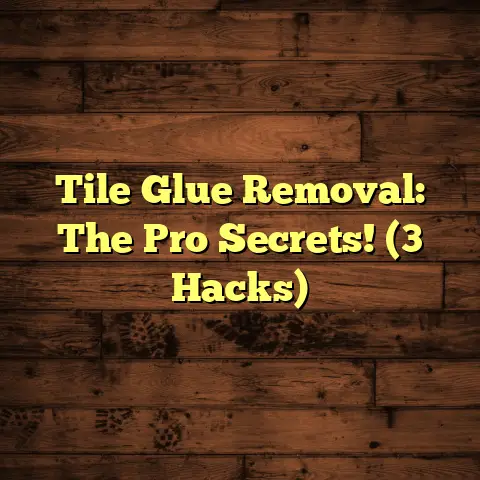How Many Nails For Hardwood Flooring? (Explained)
I still remember the first time I helped my uncle install hardwood flooring in his living room.
The smell of fresh wood, the sound of the hammer hitting the nails, and the satisfaction of seeing each plank come together made it a memorable experience.
It was more than just a project; it was about creating a space that felt warm and welcoming.
As I reflect on those days, I realize how much I’ve learned about flooring and the nuances that come with it—like how many nails you actually need for hardwood flooring.
The Basics of Nail Count
When installing hardwood flooring, the question of how many nails to use often comes up.
The nail count can depend on several factors, such as the type of flooring, the size of the boards, and the specific installation method.
Generally, I find that nailing down hardwood flooring requires about 2 to 3 nails per plank for standard 3 to 5-inch wide boards.
But what does that really mean in practical terms?
If you’re working with a room that’s 200 square feet, you’ll want to start with some basic calculations.
- Calculate the Total Area:
- A typical hardwood plank is around 6 inches wide and 3 feet long.
- In 200 square feet, you have about 400 square inches.
- This means you could fit approximately 50 boards (considering waste and cuts).
- Nail Count Calculation:
- With about 2 to 3 nails per plank, you’d need around 100 to 150 nails total.
I remember doing this math on a job site, and it helped me avoid running out of nails halfway through the project—a rookie mistake I learned from early on!
Installation Techniques
The way you install your hardwood flooring also influences the nail count.
In my experience, here are some common methods:
- Nail Down Method: This is probably the most traditional technique.
You’d use a pneumatic nail gun for efficiency.
The beauty of using a nail gun is that it drives the nails quickly and precisely, ensuring they’re sunk deep enough without damaging the wood. - Staple Down Method: Instead of nails, some opt for staples.
This approach is often quicker but requires stable subflooring to hold the staples securely. - Glue Down Method: While not about nails, I’ve encountered projects where glue was preferred over mechanical fasteners.
This can be beneficial for certain engineered woods or in areas prone to moisture.
Factors Influencing Nail Count
While I’ve shared general guidelines, several factors can tweak your nail count:
- Humidity and Temperature: Wood expands and contracts based on the climate.
In areas with high humidity, I might add an extra nail or two per plank to ensure stability. - Subfloor Type: If you’re nailing into plywood versus concrete, your approach may differ.
Concrete may require a different type of fastener altogether. - Board Thickness: Thicker boards might need more nails.
For example, when working with 3/4-inch thick hardwood compared to 1/2-inch, I’ve found that going up to 4 nails per board can offer better security.
My Experiences with Cost Estimation
When it comes to budgeting for a hardwood flooring project, I’ve learned that having accurate estimates upfront saves a lot of headaches later on.
That’s where tools like FloorTally come in handy.
This platform helps me estimate costs by pulling local material and labor rates, so I can provide clients with a realistic budget right from the start.
For example, in one recent project, I had to replace an old floor in a client’s dining room.
The estimated cost for materials came out to around $3,000, including hardwood planks and nails.
Using FloorTally, I was able to break down these costs into clear categories—making it easier for my client to understand where their money was going.
Lessons Learned Along the Way
In my flooring journey, I’ve faced both successes and challenges.
One memorable project was when I decided to do a herringbone pattern in a living room.
The elegance it brought was unmatched; however, the installation was tedious and required precise nailing—definitely more than my usual projects.
After realizing I needed a higher nail count due to the intricate design, I had to make a last-minute trip to buy more supplies.
This taught me the importance of planning ahead and being flexible with my estimates.
Tips for Getting It Right
Here are some tips I’ve picked up over the years that might help you out:
- Always Overestimate: It’s better to have too many nails than too few.
I’ve learned this lesson a few times! - Keep Your Tools Handy: A pneumatic nailer is a game changer—invest in one if you can.
- Pay Attention to Details: The spacing between nails is crucial for longevity.
I usually aim for 8 to 10 inches apart along the planks. - Prepare for Waste: Account for mistakes!
I typically add an additional 10% to my material estimates to cover any errors. - Check Local Codes: Depending on where you’re located, there may be specific codes regarding flooring installation that you need to follow.
Technical Specifications
When it comes to technical specifications for nailing hardwood floors, there are some key points to keep in mind:
- Nail Size: For standard hardwood floors, I typically use 1.5-inch or 2-inch nails.
The length depends on the thickness of your floorboards and subfloor. - Nail Type: Use finishing nails or cleat nails specifically designed for hardwood flooring.
They provide better holding power without splitting the wood.
Maintaining Your Hardwood Floor
Once you’ve completed your installation successfully, maintenance becomes key to keeping that floor looking beautiful.
Here are some quick maintenance tips that have served me well:
- Regular Cleaning: Sweeping or vacuuming should be done regularly to avoid dirt buildup.
- Use Proper Cleaners: Avoid harsh chemicals; instead, use cleaners specifically designed for hardwood floors.
- Humidity Control: Maintain a consistent level of humidity in your home—between 30% and 50%.
This helps reduce expansion and contraction over time.
A Look at Alternatives
While hardwood flooring has its charm, it’s worth considering alternatives based on your project needs:
- Engineered Wood: Offers greater stability in varying climates but may require different nailing methods.
- Laminate Flooring: Typically involves click-lock installation rather than nailing but provides a similar aesthetic at a lower cost.
Dealing with Common Problems
As much as I love working with hardwood flooring, there are challenges that come up now and then.
Here are some issues I’ve faced along with how I’ve tackled them:
- Nail Pops: Sometimes after installation, nails can pop up due to humidity changes or improper installation techniques.
To fix this, I’ve found that using a hammer or nail set to sink the nail back into place usually does the trick.
If it’s a recurring issue, it might be worth checking if you’ve used enough nails or if they’re the right type for your boards. - Splitting Boards: On occasion, I’ve encountered splitting when nailing down particularly dry or brittle boards.
To minimize this risk, I always pre-drill holes in these cases before nailing them down—especially with thicker boards. - Uneven Floors: An uneven subfloor can lead to problems down the line.
When I realize this during installation, I take extra time to level it out beforehand rather than rushing through it.
It’s all about setting a solid foundation!
Environmental Considerations
As an environmentally conscious contractor, I’ve also thought about sustainability in my flooring choices.
Here are some aspects I’ve considered:
- Sourcing Wood: Choosing hardwood from sustainably managed forests can make a big difference.
I often look for certifications like FSC (Forest Stewardship Council) when selecting materials. - Low-VOC Finishes: Choosing finishes that emit fewer volatile organic compounds (VOCs) contributes positively to indoor air quality.
- Reclaimed Wood Options: Whenever possible, I love working with reclaimed wood from old barns or buildings.
It not only adds character but also reduces waste.
The Importance of Professional Help
While DIY projects are tempting for many homeowners, there are times when hiring professionals makes sense.
Here’s why:
- Expertise: Experienced contractors know how to navigate challenges quickly and efficiently—saving time and headaches.
- Tools and Equipment: Professional installers have access to specialized tools that can ensure a smoother installation process.
- Warranty and Support: Many contractors offer warranties on their work, giving clients peace of mind in case something goes wrong later.
Engaging Clients in the Process
Over the years, I’ve realized how important it is to keep clients engaged throughout the flooring process.
Here are some ways I do this:
- Regular Updates: I make it a point to keep clients informed about progress during installation—this builds trust and keeps them excited about their new floor.
- Involving Them in Decisions: Allowing clients to choose between different nailing options or designs makes them feel invested in the project.
- Post-Installation Walkthroughs: Once everything is complete, I conduct a walkthrough explaining maintenance tips and answering any questions they may have.
Comparing Different Flooring Options
When discussing nail counts and installation methods, it’s always good to compare hardwood with other flooring options:
- Vinyl Flooring: Vinyl often uses adhesive instead of nails and can be installed more quickly but lacks the warmth of real wood.
- Bamboo Flooring: Bamboo is becoming increasingly popular due to its sustainability but requires careful handling during installation as it can splinter easily.
Preparing for Your Project
As you gear up for your own hardwood flooring project, here’s how you can prepare:
- Research Materials: Take time to understand the types of wood available—there’s oak, maple, cherry, and more!
- Take Measurements: Accurate measurements prevent waste and ensure you order enough material.
- Understand Costs: Get multiple estimates if you’re hiring out; knowing what’s reasonable can help negotiate better deals.
- Plan for Downtime: If you’re doing this yourself, factor in time for acclimation—wood needs to adapt to room conditions before installation.
Final Thoughts
My journey as a flooring contractor has taught me that every project is unique.
The number of nails for hardwood flooring isn’t just a simple calculation; it reflects the specific needs of each job and client preferences.
Through trial and error, planning ahead, and using tools like FloorTally for estimates, I’ve managed to create beautiful spaces while minimizing headaches along the way.
Whether you’re tackling your first flooring project or are a seasoned pro, paying attention to details like nail count can truly make a difference in your work’s quality and longevity.
So, what will your next flooring project look like?
Whether you’re aiming for elegance with traditional hardwood or exploring alternatives like engineered wood or laminate options, remember that preparation and attention to detail will pay off immensely in creating lasting beauty in any space!





